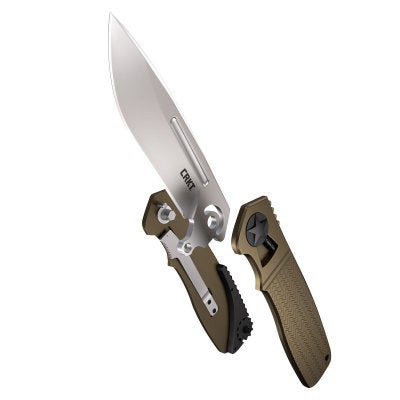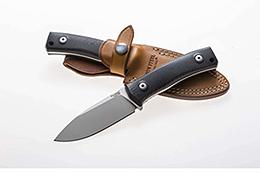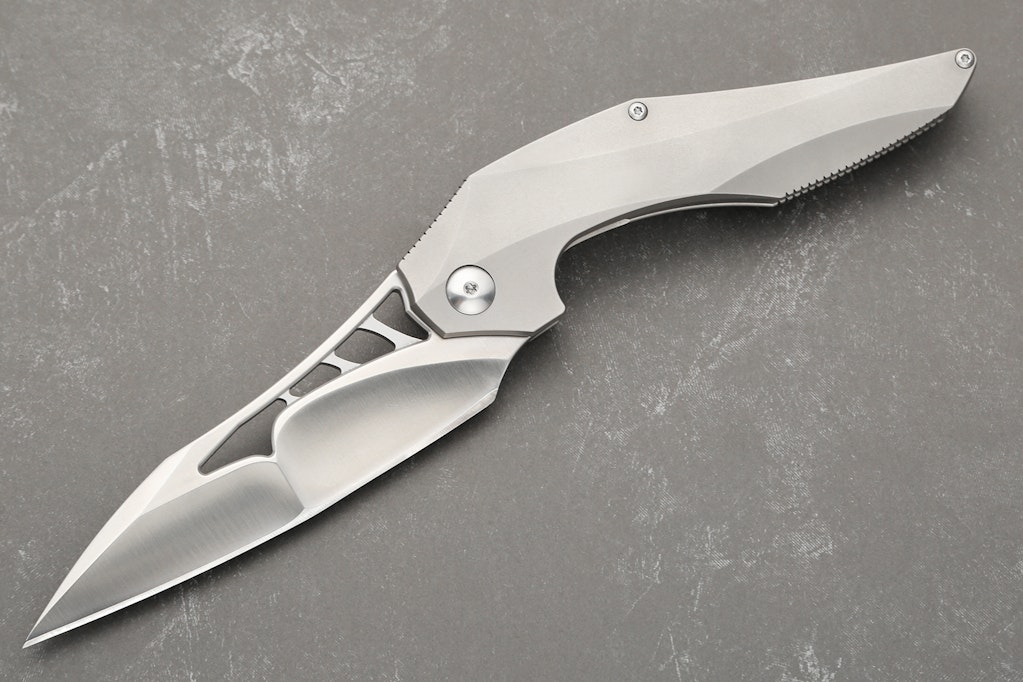Blade Show 2016 Analysis, Part II
Tony Sculimbrene 06.30.16

Spyderco, Benchmade, and KAI all brought at least (or exactly) one interesting knife. The other major brands answers that clarion call with some sweet stuff of their own. CKRT and Kizer in particular have some major additions to their line–CRKT in terms of a new system (their image as the mad scientists of knife mechanisms is still accurate) and Kizer in terms of a new style of knife–FIXED BLADES!
CRKT
The woodworking world has been obsessed with toolless use and maintenance since the hand-tightening Jacobs chuck was invented. On stuff like Festool, you expect toolless change on everything (and you get it at an extreme price premium). CRKT is bringing that sort of feature set to knives for the first time ever. The Sebenza is designed to allow folks to take their knife apart. The Homefront, from Ken Onion, takes that one step further with a knife that is designed to be taken apart WITHOUT tools. (It’s pictured at the top of this article.)
I am not sure how many people will use this feature, but just the fact that it exists is a good thing and a real innovation. The knife itself looks good. It is a medium sized drop point liner lock flipper.
CRKT has also released a few new knives that didn’t make it into the 2016 catalog. There is a larger version of the Carter Jettison, which, if it is anything like its little brother, will flip like a dream. They have also released a new fixed blade, the Clever Girl, which is collaboration with Austin McGlaun of Artificum Solis. Unlike many of McGlaun’s post-apocalyptic blades, the Clever Girl is quite clean with swooping lines and an upturned blade. It looks like a larger updated version of the old Schrade Sharpfinger. The Crawford Acquisition is also a new fixed blade with a classic “Crawford” profile. It is a medium sized fixed blade with a focus on high traction handles.
Kizer
Kizer showed off three fixed blades: a tiny knife from Matt Cucchiara, a medium sized knife from a German designer, and a large, aggressive fixed blade from Mikkel Willemsun. All of them looked decent, but the delimbing-trees-in-the-woods part of me really liked the Superbad Bowie Knife, Willemsun’s knife. It’s a bit Klingon, but really no more so than something like the Schempp Rock from Spyderco, which, as it turned out, was a fantastic user.
In a bit of insanity they had a Darrel Ralph Gunhammer. This knife design has such a bizarre and convoluted history, marked with failures and missteps, that it is hard to figure out which version, if any, to buy. But now that Kizer is making one, it makes some sense. If you always wanted a Gunhammer but were afraid to get in the swirling whirlpool of custom/midtech/junk that was out there before, this should be a safe version. They also showed over a production version of the Vagnino Lancer with all of the standard Kizer features: titanium framelock flipper, bearing pivot, and S35VN blade. It’s kinda insane that this is the “baseline” for Kizer stuff circa 2016. They are putting out very high value blades. In a move that shows Kizer’s attunement to the custom market, they scooped up a Justin Lundquist design. This is quite progressive because, other than a handful of prototypes and one off blades, Lundquist has yet to release a custom knife. Usually production companies wait for the custom maker to at least have a market before they sign up. Here, it wasn’t much of a risk as the knife is a thumb hole opening titanium framelock with a nice drop point blade. It’s different from most Kizers and quite useful looking.
They also announced that they are expanding their Vanguard line. There are going to be Cucchiara designs, Mikkel Willemsun blades, and a few in-house designs (which, overall, have been very good).
Kizer has done a lot of good work in the past three years, and Blade Show 2016 shows how far they have come. They are taking on everyone in every market–fixed blades, folders, and value folders. In particular, the Superbad Bowie looks sweet, especially for a first offering fixed blade. Finally, signing Lundquist was a good move. His knives look incredible and now people can buy them instead of fawning over them on Instagram. (I am, of course, guilty as well.)
Other stuff
Lionsteel showed off the M4, a 3.6 inch fixed blade with a variety of handles.

They look quite solid but not terribly exciting. They are also releasing a machined pen which, frankly, looks more Vegas and less carry in your pocket. They run the standard, terrible Fisher refills. It would be nice if they chose to upgrade to something like the Schmidt EasyFlow 9000 refill. Anything but the oil-slick feel of the Fisher refill.
Hogue had some stuff to show off, including a button lock flipper with a specially designed retention method.

The knife itself looks brutally aggressive with aluminum handles and a G10 inlay and many Allen Elishewitz touches. They also showed off an OTF knife, which, unsurprisingly, looks a lot like all other OFT knives. There is only so much you can do with that form, and the Benchmade Infidel and Microtechs are pretty hard to beat.
Reate, like Kizer, is clearly working hard to make in-roads into the US market. They showed off a Tashi Bharucha design as well as a few Chinese designed knives.They are also introducing a new steel CTS-204P, Carpenter’s competitor to M390 and 20CV. Finally, in a mind blowing move, they announced that they will be doing select models with mirror polish blades. If Kizer is hitting the middle of the market hard, Reate is clearly trying to grab the high end.
TOPS showed off a half dozen or so knives with 1095 steel, all of which are vaguely useful and over designed. Where you’d want a smooth end, you get a hook. When you want a choil, you get serrations. I am just not sure who buys these kinds of knives. Take a look at the Missile Strike once it comes out.
Brous Blades demoed five or six knives that Worf would love to call his EDC. They showed a fixed blade made by Millit Knives, the T5, and it looks great. It’s important because it is their first non-D2 knife as the blade is made of S35VN. YAY! Steel from a decade other than the 1960s! There were a few very curvy, very complex flippers, but all ran D2 steel. The Raven was typical of the entire line–busy, multiple grinds, recurves, and with a lot of unnecessary work done:

There were a few other knives from Brous–some running aluminum handles designed to hit a lower price point. It’s nice to see the variety of designs and new steel, but I’d love another small, true EDC knife like the Bionic, which was quite good, especially in the 2.0 version.
Overall, there was a lot of action outside the booths of Spyderco, Benchmade, and KAI. Kizer and Reate brought their A game and Brous Blades finally expanded into a new steel. The market is truly incredible right now as state of the art knives three years ago are value entries now. Between small makers allying with high end machine shops (like Brous is with Millit), CRKT signing the knife design superstar Ken Onion, and Chinese makers doing their thing, the world is a lot more competitive than it was even a decade ago.